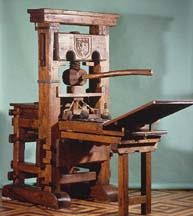
In 1555, Lyonnais publisher Jean de Tournes released a small volume of poetry titled, simply enough, OEUVRES (WORKS). The audacity of the author's byline, however, far eclipsed the book's innocuous title: LOUIZE LABE LIONNOIZE. This collection of one dialogue, three elegies and twenty-four sonnets, accompanied by twenty-four poetic "hommages" penned by other authors, was the first of its kind: a volume of poetry written by a middle-class woman and published under her own name during her lifetime. The book caused quite a stir in Lyon and changed the course of French letters forever.
A woman author, especially one from the working classes, was virtually unheard of at the time, for practical as well as moral reasons. Noblewomen composed poetry and collections of tales, but these wealthy women had the luxury of being educated by private tutors and the time to indulge their literary leanings. How did Louise Labé, daughter of a rope maker, attain her admirable command of Latin and classical literature? It is thought she attended a convent school after the death of her mother; even so, how had she convinced the sisters to teach her more than the rudiments of reading and writing, never mind allow her access to the works of the ancients? Somehow, Louise managed to educate herself and find the time to write as she fulfilled her pressing duties as the daughter of, and later wife of another, rope maker.
Receiving an education was one thing, publishing a book quite another. For a sixteenth-century woman, publishing was as scandalous an act as prostitution. The two activities were essentially the same: a female author put her private self on public display, selling her words instead of her body. Noblewomen who published could escape society's disapprobation by having a respected male vouch for their purity; no one argued when King François's sister, Marguerite de Navarre, published her poems, plays and tales. Likewise, some women authors protected themselves by concealing their identities; Marguerite de Briet published several works in the 1530's and '40's under the pseudonym Hélisenne de Crenne. A third way of validating a woman's voice was to publish her works posthumously, after her documented virtue could no longer fall into question. In 1545, the poet Maurice Scève helped publish the Rymes de Gentille et Vertueuse Dame, Pernette du Guillet soon after the death of his friend.
Louise Labé eschewed all of these protections when she published her poems in 1555. She did seek the blessing of a noble patron, but in typical iconoclastic fashion, chose a young noblewoman, fellow Lyonnaise Clémence de Bourges, rather than an established male. Louise published her poems boldly under her own name in her early thirties, while she was most definitely still alive. Unfortunately, she did pay for her audacity: for the rest of her life she was disparaged as a courtesan, especially since she seems to have carried on a long-term liaison with an Italian banker after the death of her husband. Though slandered and disdained by the general public, Louise was well respected in literary circles; she counted many well known male poets among her friends, men who praised her verse and learning. Her contribution to literary history cannot be ignored: she showed French women how to "lift their heads above the spindle" and claim their voices in the public place.
If you read French, François Rigolot published an excellent paperback edition of Louise's poetry in 1986 (Flammarion). An English translation by Annie Finch came out in 2005 (University of Chicago Press). Five of her translations can be found online here.
In a later post, I'll explain how I used Louise Labé as a model for my main character, Jollande Carlet, in The Measure of Silence.














